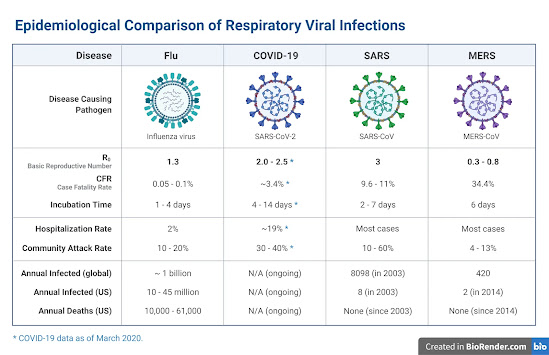 Variations in cells result in evolution. For humans, gene mutations can cause cancer, but might also have beneficial long-term implications. COVID-19 has been particularly nasty because of mutations, which are called variants.
Variations in cells result in evolution. For humans, gene mutations can cause cancer, but might also have beneficial long-term implications. COVID-19 has been particularly nasty because of mutations, which are called variants.
A relatively new term, R-naught, or RO, is more and more being mentioned. The information below was sent to me with no reference. It looks generally accurate, but I found a second source, VOX, which provides some additional details:
- In short, RO is the number of additional cases caused by an individual so infected.
- The original COVID-19 virus had an R0 of 2 or 3, so the 2.7 indicated below is just more specific.
- VOX indicates that the Delta variant has an RO of 4, but the below quote says 5.7.
- Measles has an RO of 12.
- Will future mutations make COVID-19 even worse? The answer: no one knows.
R naught: the Delta Virus has an R naught of 5.7 versus 2.7 for the original. R naught of other infectious diseases -
· 1918 Influenza Pandemic that killed 50 million people worldwide = 1.4 to 2.8
· Ebola = 1.8
· Smallpox = 3.5 to 6.0
· Polio = 5.0 to 7.0
With these factors of high R naught, additional spread by vaccinated individuals and high viral load, herd immunity will be very difficult to achieve. We would now need our population to be 92% fully vaccinated to get there. Covid-19 will be with us for a long time.
Brace yourself, it could get worse. The delta variant increases exposure and transmission. There could be a “Gamma” variant that could increase mortality in the unvaccinated, especially in babies and children.
- All the other five previous ones in modern history since 1918 were the result of HxNy influenza A and B viruses.
- There are also influenza C viruses that only causes a mild reaction, and influenza D, which affects cattle.
- Keep in mind, though, that the MERS and SARS outbreaks, both traced to bats--as is suspected of COVID-19--were also a strains of a coronavirus.
- These influenza HN types tend to come from birds and pigs.
- Both the coronavirus and influenza virus have the same spherical shape, populated by what looks suspiciously like golf tees.
- Canada beat the U.S. women's soccer team, 1-0, so we are out of the Olympics.
- Simone Biles will compete in the final balance beam competition tomorrow.
- Poland will give 24-year old Belarus sprinter Krystina Timanovskaya a visa.
- Her husband has already left the country, is in the Ukraine, and will fly to Poland.
- Poland will support her into the future.
- I've posted several times on the corrupt government of Alexander Lukashenko, who has been president since 1994. He is known as The Cockroach.
- As of Sunday night, China had the most gold medals with 29 to 22 for the USA. However, the U.S. still leads with 64 total medals to China's 62. The Russian Olympics Committee has 50.
- Final ceremonies will be televised by NBC from 7AM EDT on Sunday, August 8. This will be repeated at 7:30PM.
The 2022 Winter Olympics will be held this coming February 4-22 in Beijing, while the next Summer Olympics will occur in Paris from July 26 to August 11, 2024.
-


















Comments
Post a Comment